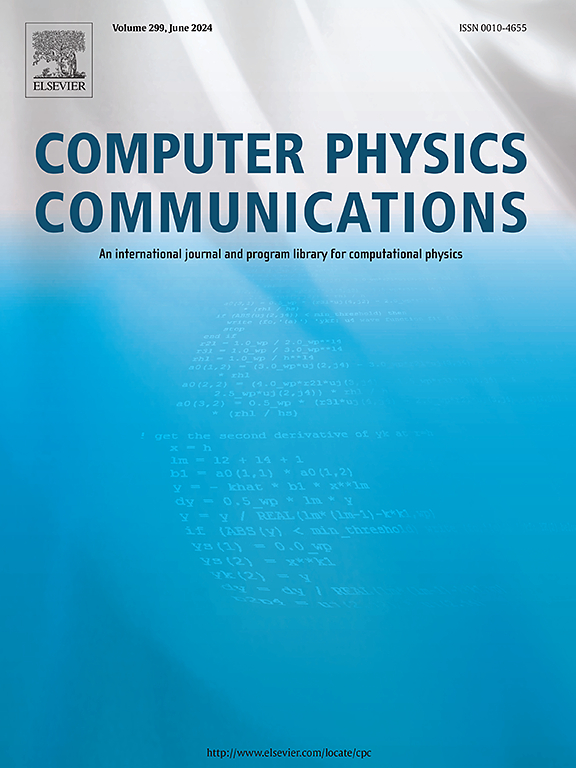MemriSim:模拟氧化物忆阻器中电子传输的理论框架
IF 7.2
2区 物理与天体物理
Q1 COMPUTER SCIENCE, INTERDISCIPLINARY APPLICATIONS
引用次数: 0
摘要
我们开发了一个理论框架 MemriSim,用于模拟氧化物忆阻器的电阻开关行为。MemriSim 包括两个主要部分:i) 利用动力学蒙特卡洛(kMC)算法计算导电丝形成/断裂过程中氧空位的结构演变;ii) 基于 kMC 衍生结构的电子隧道和热离子发射情景进行传输计算。作为原型探测器,我们计算了基于 HfO2 和 TaOx 的忆阻器的电流-电压(I-V)曲线,并将结果与实验测量结果进行了比较,结果显示两者完全一致。通过调整物理参数,MemriSim 可以描述具有不同氧化层和金属电极的电阻开关器件。此外,还可以通过考虑 RLC 电路的瞬态响应来模拟脉冲瞬态电流。所开发的框架不仅为理解氧化物中电阻开关的基本机制提供了一种通用方法,还为设计和优化基于忆阻器的非易失性存储器、内存逻辑和神经形态计算架构提供了新的机遇:MemriSim.CPC 库链接到程序文件:https://doi.org/10.17632/8gbbgf8z49.1Licensing 规定:GPLv2.编程语言:C++C++.Supplementary material:问题性质:模拟基于氧化物的忆阻器电阻开关特性的通用框架;生成灯丝形成/断裂过程中的氧化层结构;计算忆阻器的 I-V 曲线;模拟脉冲瞬态电流;预测新器件的电阻开关性能:求解方法:框架采用 kMC 算法进行结构演化,通过泊松方程计算氧化层内部的电场,基于电子隧道和热离子发射进行传输计算。本文章由计算机程序翻译,如有差异,请以英文原文为准。
MemriSim: A theoretical framework for simulating electron transport in oxide memristors
We have developed a theoretical framework MemriSim for simulating the resistive switching behaviors of oxide memristors. MemriSim comprises two major parts, i) structural evolution of oxygen vacancies during conductive filament formation/rupture by kinetic Monte Carlo (kMC) algorithm, and ii) transport calculations based on the scenario of electron tunneling and thermionic emission with the kMC derived structures. As prototype probes, we have computed the current-voltage (I-V) curves of HfO2 and TaOx based memristors and compared the results with experimental measurements, which show perfect agreement. By tuning the physical parameters, MemriSim can describe resistive switching devices with different oxide layers and metal electrodes. In addition, the pulse transient current can also be simulated by considering the transient response of RLC circuit. The developed framework not only provides a general approach for understanding the fundamental mechanism of resistive switching in oxides, but also opens up new opportunities for designing and optimizing memristor-based architectures for nonvolatile memory, logic-in-memory and neuromorphic computing.
Program summary
Program Title: MemriSim.
CPC Library link to program files: https://doi.org/10.17632/8gbbgf8z49.1
Licensing provisions: GPLv2.
Programming language: C++.
Supplementary material: Supplementary material is available.
Nature of problem: A general framework for simulating the resistive switching properties of oxide-based memristors; generate the structure of oxide layer during filament formation/rupture; calculate the I-V curves of memristive device; simulate the pulse transient current; predict the resistive switching performance of new devices.
Solution method: The framework uses kMC algorithm for structural evolution, the electric field inside oxide layer is computed by the Poisson's equation, and the transport calculation is based on electron tunneling and thermionic emission.
求助全文
通过发布文献求助,成功后即可免费获取论文全文。
去求助
来源期刊

Computer Physics Communications
物理-计算机:跨学科应用
CiteScore
12.10
自引率
3.20%
发文量
287
审稿时长
5.3 months
期刊介绍:
The focus of CPC is on contemporary computational methods and techniques and their implementation, the effectiveness of which will normally be evidenced by the author(s) within the context of a substantive problem in physics. Within this setting CPC publishes two types of paper.
Computer Programs in Physics (CPiP)
These papers describe significant computer programs to be archived in the CPC Program Library which is held in the Mendeley Data repository. The submitted software must be covered by an approved open source licence. Papers and associated computer programs that address a problem of contemporary interest in physics that cannot be solved by current software are particularly encouraged.
Computational Physics Papers (CP)
These are research papers in, but are not limited to, the following themes across computational physics and related disciplines.
mathematical and numerical methods and algorithms;
computational models including those associated with the design, control and analysis of experiments; and
algebraic computation.
Each will normally include software implementation and performance details. The software implementation should, ideally, be available via GitHub, Zenodo or an institutional repository.In addition, research papers on the impact of advanced computer architecture and special purpose computers on computing in the physical sciences and software topics related to, and of importance in, the physical sciences may be considered.
 求助内容:
求助内容: 应助结果提醒方式:
应助结果提醒方式:


